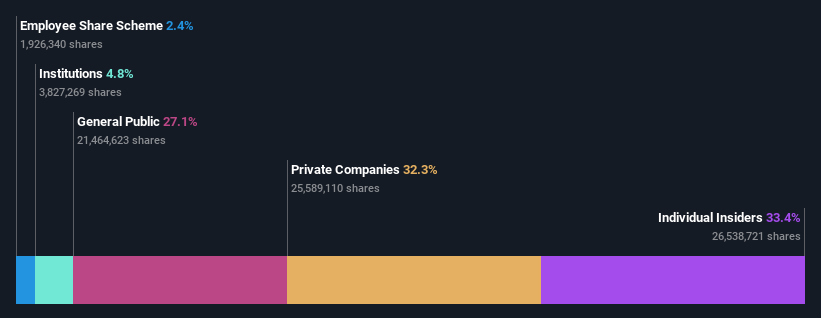- Taiwan
- /
- Hospitality
- /
- TWSE:8462
Power Wind Health Industry Incorporated (TWSE:8462) adds NT$1.3b in market cap and insiders have a 33% stake in that gain

Key Insights
- Insiders appear to have a vested interest in Power Wind Health Industry's growth, as seen by their sizeable ownership
- 55% of the business is held by the top 6 shareholders
- Ownership research, combined with past performance data can help provide a good understanding of opportunities in a stock
If you want to know who really controls Power Wind Health Industry Incorporated (TWSE:8462), then you'll have to look at the makeup of its share registry. And the group that holds the biggest piece of the pie are individual insiders with 33% ownership. Put another way, the group faces the maximum upside potential (or downside risk).
As a result, insiders scored the highest last week as the company hit NT$11b market cap following a 14% gain in the stock.
In the chart below, we zoom in on the different ownership groups of Power Wind Health Industry.
View our latest analysis for Power Wind Health Industry

What Does The Institutional Ownership Tell Us About Power Wind Health Industry?
Many institutions measure their performance against an index that approximates the local market. So they usually pay more attention to companies that are included in major indices.
Since institutions own only a small portion of Power Wind Health Industry, many may not have spent much time considering the stock. But it's clear that some have; and they liked it enough to buy in. If the business gets stronger from here, we could see a situation where more institutions are keen to buy. When multiple institutional investors want to buy shares, we often see a rising share price. The past revenue trajectory (shown below) can be an indication of future growth, but there are no guarantees.

Power Wind Health Industry is not owned by hedge funds. JiaYong Investment and Development Co., Ltd. is currently the largest shareholder, with 27% of shares outstanding. Zong Yu is the second largest shareholder owning 6.3% of common stock, and Shuqi Zhang holds about 5.4% of the company stock. Shuqi Zhang, who is the third-largest shareholder, also happens to hold the title of Member of the Board of Directors.
We also observed that the top 6 shareholders account for more than half of the share register, with a few smaller shareholders to balance the interests of the larger ones to a certain extent.
While studying institutional ownership for a company can add value to your research, it is also a good practice to research analyst recommendations to get a deeper understand of a stock's expected performance. While there is some analyst coverage, the company is probably not widely covered. So it could gain more attention, down the track.
Insider Ownership Of Power Wind Health Industry
While the precise definition of an insider can be subjective, almost everyone considers board members to be insiders. Management ultimately answers to the board. However, it is not uncommon for managers to be executive board members, especially if they are a founder or the CEO.
Insider ownership is positive when it signals leadership are thinking like the true owners of the company. However, high insider ownership can also give immense power to a small group within the company. This can be negative in some circumstances.
Our most recent data indicates that insiders own a reasonable proportion of Power Wind Health Industry Incorporated. It has a market capitalization of just NT$11b, and insiders have NT$3.6b worth of shares in their own names. We would say this shows alignment with shareholders, but it is worth noting that the company is still quite small; some insiders may have founded the business. You can click here to see if those insiders have been buying or selling.
General Public Ownership
With a 27% ownership, the general public, mostly comprising of individual investors, have some degree of sway over Power Wind Health Industry. This size of ownership, while considerable, may not be enough to change company policy if the decision is not in sync with other large shareholders.
Private Company Ownership
It seems that Private Companies own 32%, of the Power Wind Health Industry stock. It might be worth looking deeper into this. If related parties, such as insiders, have an interest in one of these private companies, that should be disclosed in the annual report. Private companies may also have a strategic interest in the company.
Next Steps:
While it is well worth considering the different groups that own a company, there are other factors that are even more important.
I like to dive deeper into how a company has performed in the past. You can access this interactive graph of past earnings, revenue and cash flow, for free.
But ultimately it is the future, not the past, that will determine how well the owners of this business will do. Therefore we think it advisable to take a look at this free report showing whether analysts are predicting a brighter future.
NB: Figures in this article are calculated using data from the last twelve months, which refer to the 12-month period ending on the last date of the month the financial statement is dated. This may not be consistent with full year annual report figures.
New: Manage All Your Stock Portfolios in One Place
We've created the ultimate portfolio companion for stock investors, and it's free.
• Connect an unlimited number of Portfolios and see your total in one currency
• Be alerted to new Warning Signs or Risks via email or mobile
• Track the Fair Value of your stocks
Have feedback on this article? Concerned about the content? Get in touch with us directly. Alternatively, email editorial-team (at) simplywallst.com.
This article by Simply Wall St is general in nature. We provide commentary based on historical data and analyst forecasts only using an unbiased methodology and our articles are not intended to be financial advice. It does not constitute a recommendation to buy or sell any stock, and does not take account of your objectives, or your financial situation. We aim to bring you long-term focused analysis driven by fundamental data. Note that our analysis may not factor in the latest price-sensitive company announcements or qualitative material. Simply Wall St has no position in any stocks mentioned.
About TWSE:8462
Power Wind Health Industry
Engages in the business of membership-based fitness center chains, leisure sports venues, and other sports services in Taiwan.
Reasonable growth potential with proven track record and pays a dividend.

